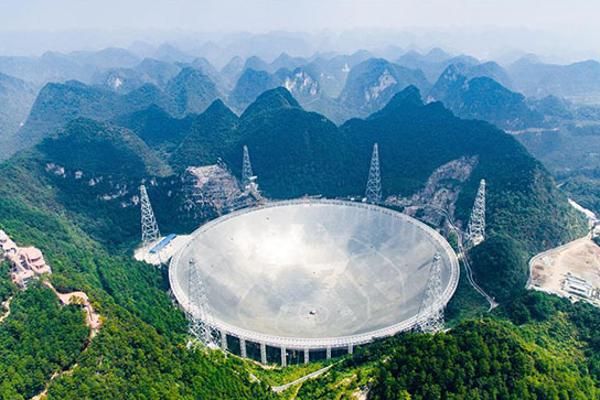
Photo taken on Sept 24, 2016 shows the 500-meter Aperture Spherical Telescope (FAST) in Pingtang County, Southwest China’s Guizhou province. The FAST, world’s largest radio telescope, measuring 500 meters in diameter, was completed and put into use on Sept 25. [Photo/Xinhua]
BEIJING — With a series of scientific breakthroughs during the past year, China is ushering in 2017 looking to grow into one of the world’s great innovators.
In his New Year speech, President Xi Jinping touched on many scientific and technological achievements made in 2016, such as the Five-hundred-meter Aperture Spherical Telescope (FAST) being put into operation, and the Dark Matter Particle Explorer Satellite “Wukong” in orbit for a year.
He also mentioned launching of a quantum satellite and the Shenzhou-11 and Tiangong-2 space missions.
“We have made a series of breakthroughs this year and established a set of regulations as well as a quality guarantee system. We have also built a young and capable team,” said Li Jian, head of the Beijing Aerospace Control Center.
FAST, the world’s largest radio telescope, was put into use in September in Southwest China to observe space and look for extraterrestrial life.
The telescope may help people better understand the origin and structure of the universe, and accelerate the search for life beyond earth.
China’s first dark-matter detection satellite “Wukong,” named after the legendary Monkey King, was sent into space in December 2015 to search for signals of dark matter, invisible material that scientists say makes up most of the universe’s mass.
The quantum satellite was sent into space in August in an effort to start “hack-proof” quantum communications by transmitting uncrackable keys from space to the ground.
Launched on Oct 17, the Shenzhou-11 spacecraft docked two days later with China’s first space lab Tiangong-2 where two astronauts lived for 30 days, the longest time Chinese astronauts have spent in space.
Besides space technology, China has seen outstanding achievements in other cutting edge areas during 2016.
In June, China’s new supercomputing system Sunway-TaihuLight was named the world’s fastest computer at the International Supercomputing Conference in Germany.
In September, a national genebank with more than 10 million bio-samples was opened to work on human health research and the conservation of global bio-diversity.
Aside from major cutting-edge fields, the country’s innovation strength can be seen in individual companies in all areas.
According to a report published by the World Intellectual Property Organization (WIPO), China ranked top in the world for patent applications, receiving over one million applications in 2015.
China joined the ranks of the world’s top 25 innovative economies in the Global Innovation Index released by Cornell University, INSEAD and WIPO in August.
“This is in keeping with all the developments that we have seen in China in recent years, including the use of innovation as a major component in the transition of the Chinese economy from ‘made in China’ to ‘created in China,’” WIPO Director General Francis Gurry said.
As a country determined to pursue innovation-driven development, China is ready to make even bigger moves in the future.
Three major steps are to be taken on China’s innovation-driven development, according to guidelines unveiled in May.
The guidelines said the country would be an “innovative nation” by 2020, an international leader in innovation by 2030, and a world powerhouse of scientific and technological innovation by 2050.
